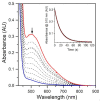Mimicking Elementary Reactions of Manganese Lipoxygenase Using Mn-hydroxo and Mn-alkylperoxo Complexes
- PMID: 34885729
- PMCID: PMC8659247
- DOI: 10.3390/molecules26237151
Mimicking Elementary Reactions of Manganese Lipoxygenase Using Mn-hydroxo and Mn-alkylperoxo Complexes
Abstract
Manganese lipoxygenase (MnLOX) is an enzyme that converts polyunsaturated fatty acids to alkyl hydroperoxides. In proposed mechanisms for this enzyme, the transfer of a hydrogen atom from a substrate C-H bond to an active-site MnIII-hydroxo center initiates substrate oxidation. In some proposed mechanisms, the active-site MnIII-hydroxo complex is regenerated by the reaction of a MnIII-alkylperoxo intermediate with water by a ligand substitution reaction. In a recent study, we described a pair of MnIII-hydroxo and MnIII-alkylperoxo complexes supported by the same amide-containing pentadentate ligand (6Medpaq). In this present work, we describe the reaction of the MnIII-hydroxo unit in C-H and O-H bond oxidation processes, thus mimicking one of the elementary reactions of the MnLOX enzyme. An analysis of kinetic data shows that the MnIII-hydroxo complex [MnIII(OH)(6Medpaq)]+ oxidizes TEMPOH (2,2'-6,6'-tetramethylpiperidine-1-ol) faster than the majority of previously reported MnIII-hydroxo complexes. Using a combination of cyclic voltammetry and electronic structure computations, we demonstrate that the weak MnIII-N(pyridine) bonds lead to a higher MnIII/II reduction potential, increasing the driving force for substrate oxidation reactions and accounting for the faster reaction rate. In addition, we demonstrate that the MnIII-alkylperoxo complex [MnIII(OOtBu)(6Medpaq)]+ reacts with water to obtain the corresponding MnIII-hydroxo species, thus mimicking the ligand substitution step proposed for MnLOX.
Keywords: alkylperoxo; hydrogen-atom transfer; ligand substitution; lipoxygenase; manganese enzymes.
Conflict of interest statement
The authors declare no conflict of interest.
Figures













References
MeSH terms
Substances
Grants and funding
LinkOut - more resources
Full Text Sources

